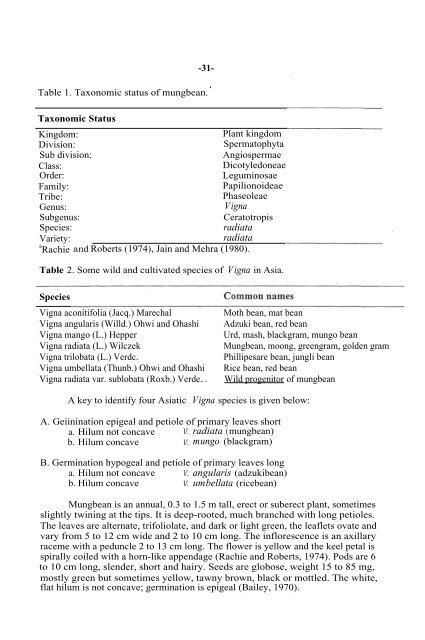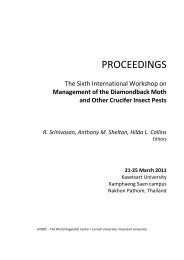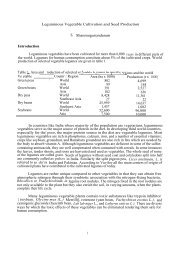MUNGBEAN VARIETAL IMPROVEMENT S. Shanmugasundaram
MUNGBEAN VARIETAL IMPROVEMENT S. Shanmugasundaram
MUNGBEAN VARIETAL IMPROVEMENT S. Shanmugasundaram
You also want an ePaper? Increase the reach of your titles
YUMPU automatically turns print PDFs into web optimized ePapers that Google loves.
-31-<br />
Table 1. Taxonomic status of mungbean. '<br />
Taxonomic Status<br />
Kingdom:<br />
Division:<br />
Sub division:<br />
Class:<br />
Order:<br />
Family:<br />
Tribe:<br />
Genus:<br />
Subgenus:<br />
Species:<br />
Variety:<br />
a Rachie and Roberts (1974), Jain and Mehra (1980).<br />
Plant kingdom<br />
Spermatophyta<br />
Angiospermae<br />
Dicotyledoneae<br />
Leguminosae<br />
Papilionoideae<br />
Phaseoleae<br />
Vigna<br />
Ceratotropis<br />
radiata<br />
radiata<br />
Table 2. Some wild and cultivated species of Vigna in Asia.<br />
Species<br />
Vigna aconitifolia (Jacq.) Marechal<br />
Vigna angularis (Willd.) Ohwi and Ohashi<br />
Vigna mango (L.) Hepper<br />
Vigna radiata (L.) Wilczek<br />
Vigna trilobata (L.) Verdc.<br />
Vigna umbellata (Thunb.) Ohwi and Ohashi<br />
Vigna radiata var. sublobata (Roxb.) Verde. .<br />
Moth bean, mat bean<br />
Adzuki bean, red bean<br />
Urd, mash, blackgram, mungo bean<br />
Mungbean, moong, greengram, golden gram<br />
Phillipesare bean, jungli bean<br />
Rice bean, red bean<br />
Wild progenitor of mungbean<br />
A key to identify four Asiatic Vigna species is given below:<br />
A. Geiinination epigeal and petiole of primary leaves short<br />
a. Hilum not concave V. radiata (mungbean)<br />
b. Hilum concave V. mungo (blackgram)<br />
B. Germination hypogeal and petiole of primary leaves long<br />
a. Hilum not concave V. angularis (adzukibean)<br />
b. Hilum concave V. umbellata (ricebean)<br />
Mungbean is an annual, 0.3 to 1.5 m tall, erect or suberect plant, sometimes<br />
slightly twining at the tips. It is deep-rooted, much branched with long petioles.<br />
The leaves are alternate, trifoliolate, and dark or light green, the leaflets ovate and<br />
vary from 5 to 12 cm wide and 2 to 10 cm long. The inflorescence is an axillary<br />
raceme with a peduncle 2 to 13 cm long. The flower is yellow and the keel petal is<br />
spirally coiled with a horn-like appendage (Rachie and Roberts, 1974). Pods are 6<br />
to 10 cm long, slender, short and hairy. Seeds are globose, weight 15 to 85 mg,<br />
mostly green but sometimes yellow, tawny brown, black or mottled. The white,<br />
flat hilum is not concave; germination is epigeal (Bailey, 1970).

















